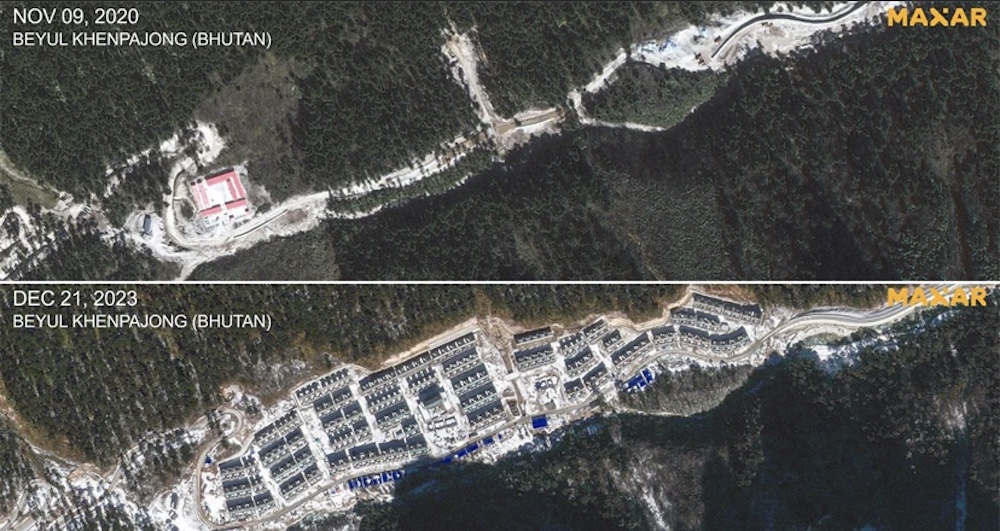By Tenzin Nyidon
DHARAMSHALA, Jan 9: Recent satellite imagery, dated less than a month ago, has revealed an alarming acceleration in China’s illicit construction activities within the Beyul Khenpajong region of northeast Bhutan. The images captured the rapid development of Chinese townships along a river valley, encroaching upon an area of profound historical and cultural significance to Bhutan’s royal family.
Despite ongoing border negotiations between Thimphu and Beijing, the latest high-resolution satellite images vividly depict the extensive expansion of Chinese construction within the Beyul Khenpajong area including the establishment of townships, infrastructure projects, and structures built along the river valley.
The comparison between the images from November 2020 and December 21, 2023, highlighted a significant escalation in China’s incursion into Bhutanese territory, particularly in terms of construction activity and infrastructure development. The November 2020 image showed a relatively smaller incursion by China into Bhutanese territory, indicating some construction activities in progress. However, the more recent images from December 21, 2023, reveal a stark transformation in the encroached area. The land has been developed into a fully-fledged township equipped with a well-established road network, capable of accommodating a substantial population, potentially in the hundreds.
Bhutan’s Ambassador to New Delhi Major General Vetsop Namgyel (retd.), concerning China’s illegal land grab into Bhutanese territory, said, “While it is our policy not to give comments to the media on the ongoing border talks, I would like to state that we will always uphold and safeguard Bhutan’s territorial interests during the boundary negotiations.”
China and Bhutan signed a ‘three-step road map’ in 2020 to resolve their longstanding border dispute (across Chinese-occupied Tibet). Thimphu expressed hopes that this agreement would lead to a demarcated border, effectively putting an end to Chinese intrusions into Bhutanese territory.
The diplomatic engagement between China and Bhutan gained momentum when Bhutan’s Foreign Minister, Tandi Dorji, undertook a visit to Beijing in October of the preceding year. During the same month, Prime Minister Lotay Tshering expressed optimism regarding the prospects of delineating a proper border between China and Bhutan. While Thimphu has not publicly disclosed the progress made in these discussions, there have been indications that New Delhi was kept informed about the latest developments in the talks.
The Doklam plateau has been a focal point of the border dispute between China and Bhutan, holding strategic significance not only for Bhutan but also for India due to its proximity to the Siliguri Corridor, also known as the “Chicken’s Neck.” The Siliguri Corridor is a narrow strip of land that connects the north-eastern states of India with the rest of the country. Any disturbances or alterations in this area could have significant implications for India’s territorial integrity and strategic connectivity with its north-eastern states.
The Doklam standoff in 2017 between Indian and Chinese troops occurred precisely in this region. Experts say that India’s interest in the resolution of the Doklam dispute stems from its security concerns and the need to protect the Siliguri Corridor, a crucial passage linking the mainland to its north-eastern states.
Bhutan’s stance on any potential resolution involving the Doklam plateau aligns with India’s interests, as Bhutan recognises India as an involved party due to the strategic implications for its security and territorial integrity. Bhutan has emphasised that any agreement or negotiation concerning Doklam should also involve India, reflecting its acknowledgment of India’s security concerns in the region.










